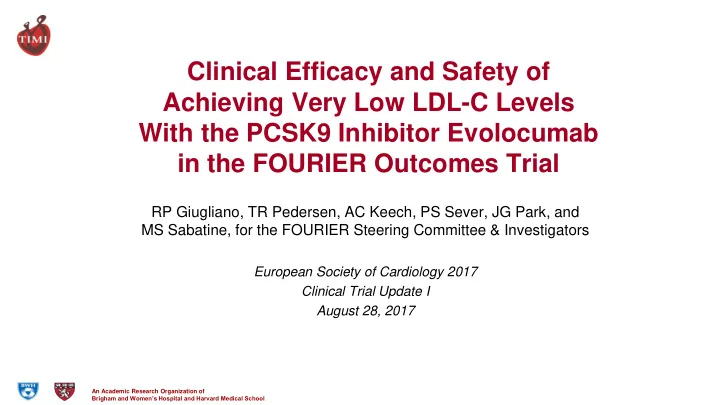

Clinical Efficacy and Safety of Achieving Very Low LDL-C Levels With the PCSK9 Inhibitor Evolocumab in the FOURIER Outcomes Trial RP Giugliano, TR Pedersen, AC Keech, PS Sever, JG Park, and MS Sabatine, for the FOURIER Steering Committee & Investigators European Society of Cardiology 2017 Clinical Trial Update I August 28, 2017 An Academic Research Organization of Brigham and Women’s Hospital and Harvard Medical School
An Academic Research Organization of Confidential Brigham and Women’s Hospital and Harvard Medical School
Summary of FOURIER • LDL-C by 59% (from 2.4 -> 0.8 [0.5, 1.2] mM) • CV outcomes in patients already on statin therapy • Evolocumab was safe and well-tolerated Placebo HR 0.85 (0.79-0.92) Evolocumab P<0.0001 2.5 Placebo HR 0.80 14.6 15 (0.73-0.88) KM Rate (%) at 3 Years 12.6 2.0 59% mean decline P<0.00001 LDL-C (mM) P<0.00001 9.9 1.5 10 Absolute ↓ 1.45 mM 7.9 (1.42-1.47) 1.0 5 Evolocumab 0.5 Median 0.78 mM IQR [0.49-1.27] 0.0 0 CV death, MI, stroke, CV death, MI, stroke 0 4 12 24 48 72 96 120 144 168 UA, cor revasc Weeks after randomization An Academic Research Organization of Brigham and Women’s Hospital and Harvard Medical School Sabatine MS et al. New Engl J Med 2017;376:1713-22
Methods – LDL-C assessed at 4 wks (ultracentrifugation if <1 mM) – Analyzed 5 groups by achieved LDL-C at 4 weeks 1) <0.5mM (20 mg/dL) 2) 0.5-1.3 mM (20- 49 mg/dL) 3) 1.3-1.8 mM (50-69 mg/dL) 4) 1.8-2.6mM (70-99 mg/dL) 5) >2.6 mM (>100 mg/dL) was the referent group – Pooled results across 2 Rx groups (evo, placebo) – Prespecified 1° and 2° efficacy composite endpoints – 10 safety adverse events evaluated: – Cognition 1 assessed by CANTAB and pt survey of everyday cognition 1582 pts with events in first 4 wks or no LDL-C at week 4 were excluded An Academic Research Organization of Brigham and Women’s Hospital and Harvard Medical School Giugliano RP, ESC Congress 2017, Barcelona 8/28/2017
CV Death, MI, or Stroke LDL-C (mM) Adj HR (95% CI) <0.5 0.69 (0.56-0.85) 0.5-1.3 0.75 (0.64-0.86) 1.3-1.8 0.87 (0.73-1.04) 1.8-2.6 0.90 (0.78-1.04) P = 0.0001 > 2.6 referent LDL-C (nM) at 4 weeks An Academic Research Organization of Brigham and Women’s Hospital and Harvard Medical School Giugliano RP, ESC Congress 2017, Barcelona 8/28/2017
Safety Events % Patients (n/N) % pts % pts LDL-C (mM) at 25 10 <0.5 0.5-1.3 20 1.3-1.8 1.8-2.6 15 ≥2.6 5 Adj P-values for trend >0.10 for each comparison 10 5 0 0 An Academic Research Organization of Brigham and Women’s Hospital and Harvard Medical School Giugliano RP, ESC Congress 2017, Barcelona 8/28/2017
Exploratory Analysis Pts with LDL-C <0.26 mM (<10 mg/dL) at 4 wks N=504: Median [IQR] LDL-C 0.18 [0.13-0.23] nM = 7 [5-9] mg/dL Cardiovascular Efficacy Safety ≥2.6 mM HR 0.69 (0.49-0.97) ≥2.6 mM 15 HR 0.94 (0.74-1.20) 30 P=0.03 <0.26 mM P=0.61 <0.26 mM 11.9 25 23.3 22.8 HR 0.59 (0.37-0.92) 10 P=0.02 20 7.8 7.3 15 4.4 5 HR 1.08 (0.63-1.85) 10 P=0.78 3.4 3.4 5 0 0 CVD, MI, Stroke, CVD, MI, Stroke Serious adverse AE -> drug UA, Cor Revasc event discontinued An Academic Research Organization of Brigham and Women’s Hospital and Harvard Medical School Giugliano RP, ESC Congress 2017, Barcelona 8/28/2017
Conclusions LDL-C can now be reduced to unprecedented low levels with statin + PCSK9i (<< 1 mM) A strong linear relationship of achieved LDL-C and CV events seen, down to an LDL <0.26 mM No excess in safety events with very low achieved LDL-C <20 mg/dL at 2.2 years These data suggest that we should target considerably lower LDL-C than is currently recommended for our patients with atherosclerotic CV disease An Academic Research Organization of Brigham and Women’s Hospital and Harvard Medical School Giugliano RP, ESC Congress 2017, Barcelona 8/28/2017
Recommend
More recommend